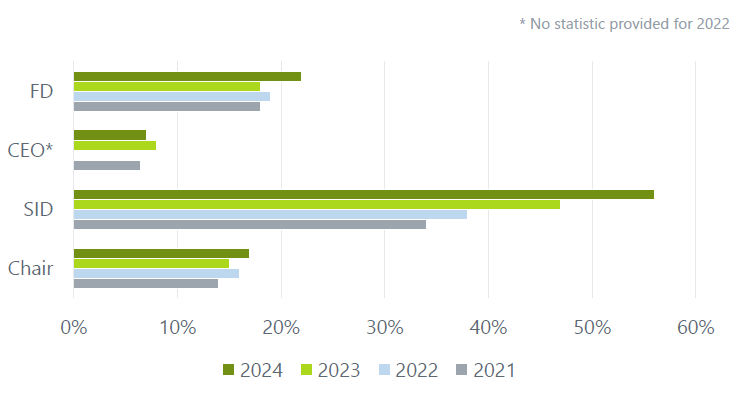Ellason lens on… FTSE Women Leaders Review: what should companies be focussing on now
Wed 05, March
The recently-published FTSE Women Leaders Review 2025 report (link) shows progress towards achieving 40% women on FTSE 350 Boards continues, with almost three-quarters of FTSE 350 companies having 40% or higher female representation on their boards. This represents an increase from 67% in 2023 and from only 2% a decade ago in 2014. There has also been a small improvement to 35.3% in women’s representation in leadership roles (defined as the Executive Committee and its direct reports).
The keys findings are:
- 43.4% of FTSE 350 directorships are held by women. Analysing this data further highlights that although parity has been achieved for non-executive roles, progression in executive roles is markedly slower with only 15.6% of executive roles being filled by women. With an appointment rate of women to FTSE 350 executive director roles of only 25%, increasing the representation of women in executive roles will remain slow.
- The number of women in leadership roles has marginally increased to 35.5%, this translates to 28% of FTSE 350 companies operating with leadership teams where women represent at least 40% of the membership. However, 101 companies are yet to achieve the 33% target set for the end of 2020 by the Hampton-Alexander Review.
- Over 70% of FTSE 350 companies now have a woman in at least one of the four key board roles (Chair, CEO, FD, SID). The success in achieving this target is largely attributable to the appointment of women to the SID role. In contrast the number of women in the CEO role has fallen back to 19 compared to 18 in 2016. Representation across these four roles in the FTSE 350 is:

- A third of the top 50 private companies have achieved or exceeded the 40% target. However, there are still 54% of companies with lower than 33% women representation. Interestingly, 29% of executive directors are women, higher than the 15.6% in the FTSE 350.
Ellason commentary: Diversity plays an important role in achieving high-performing, effective boards. Diverse boards are more likely to out-perform those who do not have diverse boards (McKinsey 2023*). A diverse range of skills and experience in board composition enables robust challenge, decisions informed by consideration of different perspectives, innovation and mitigates against the risk of “group-think”. Therefore, it is encouraging to see the growing representation of women on boards and in leadership teams. This progress is a significant step forward, yet the results highlight there is more to be done. While we should celebrate the achievements, it is important to recognise that much of the recent progress reflects what can be considered “easier wins” – namely, the appointment of women to NED and SID roles.
Diversity targets have been an effective catalyst for driving a step change in female representation on boards. For the next stage of the journey, companies will be looking to ensure that there is a diverse pipeline so these levels of diversity are maintained. However, the slower progress of women representation in the four key board roles (excluding SID) is evidence that a target alone will not create the pipeline.
Mentorship and targeted leadership development programmes remain valuable tools for signalling the importance of diversity and supporting skill development but they must be complemented by ‘business-as-usual’ structures that deliver diverse talent pools at all levels of the organisation.
An area of focus for companies in this next stage is to assess whether their job architecture and grading framework are sufficiently robust to support the diversity objective. A well-designed framework can support companies in developing diverse pipelines by providing visibility to all talent in the organisation. This enables promotion decisions and succession planning to be underpinned by objective criteria, mitigating against unconscious bias that can otherwise creep into promotion decisions. From the employee and manager perspectives, these structures can also support diversity on an individual level by enabling:
- Clarity on career progression, giving all employees equal access to the information needed to advance their careers.
- Standardised job descriptions, removing subjectivity from manager assessment in hiring and promotion decisions.
- An objective reward strategy where pay can be clearly linked to role and not the individual.
In conclusion, while significant progress has been made against diversity targets, maintaining these levels will require continued focus on developing diverse pipelines and career progression structures that are merit-based and free of unconscious bias.
*McKinsey, The Case for Diversity and Holistic Impact, 2023: top quartile companies for gender diversity are 39% more likely to outperform peers